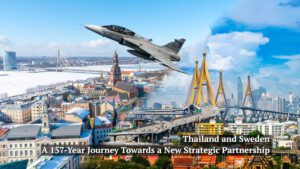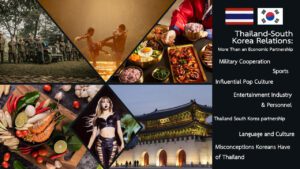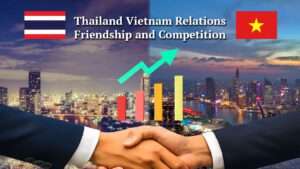Deep Dive into the Thailand Vietnam Relations – Friendship and Competition
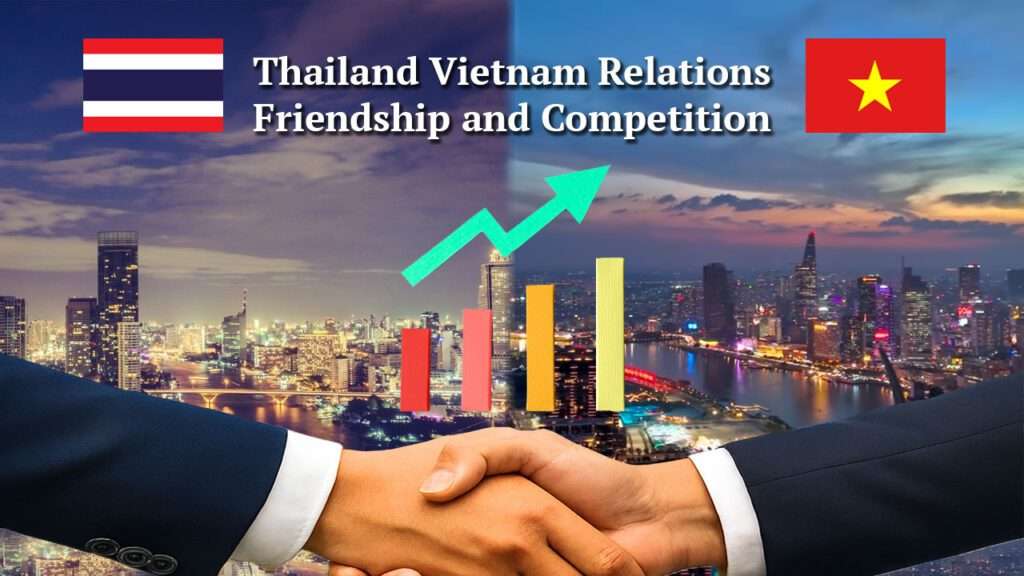
My visit to Vietnam is now on its second day. I am looking into the complex and vital Thailand Vietnam Relations. These two ASEAN nations are geographically and culturally close. Yet, they act as both “friends” and “competitors” globally.
Economic Foundation: From Top Partner to $25 Billion Goal
Economic collaboration forms the strongest basis of the relationship. Thailand consistently stands as Vietnam’s Biggest ASEAN Trading Partner. Bilateral trade reached around $16.6 billion in the first ten months of 2024. Both nations aim for an ambitious trade goal. They target $25,000 million USD by 2025.
- Key Thai Exports to Vietnam: Thailand maintains a trade surplus with Vietnam. Crucial exports include Automobiles, parts and components. Thailand is a regional auto production hub. Other significant exports are Plastic pellets, Refined fuel, and Fresh/frozen fruits.
- Key Vietnamese Imports to Thailand: Imports from Vietnam show strong growth. These include Household electrical appliances. Other key imports are Electrical machinery and components. Iron and steel products also feature prominently. This reflects Vietnam’s growing manufacturing sector.
Regarding investment, Thailand is a major foreign investor in Vietnam. It currently ranks 7th in FDI inflows to Vietnam. Thai businesses have established production bases. They have actively expanded their retail markets here. This shows confidence in Vietnam’s economic potential and growth.
The Dynamic of Competitor and Partner
A key point of interest is Vietnam’s dual role. Vietnam is seen as a key trading partner and a major global competitor.
- The Competition: Vietnam’s competitiveness has rapidly increased. This is especially true in attracting FDI Vietnam vs Thailand. This growth is fueled by lower labor costs. It is also driven by open investment promotion policies. Vietnam has become a crucial global manufacturing base. This particularly applies to the high-tech and electronics industries. This presents a challenge for Thailand’s manufacturing sector.
- The Partnership: Despite the rivalry, the two nations are indispensable “partners.” Thai Thai Investment in Vietnam is significant. They rely on each other within the regional supply chain. Cooperation under the ASEAN framework is essential. Vietnam’s growth is clearly an opportunity for Thailand. It is an opportunity for trade and investment.
Thai Investment in Vietnam: A Deep Dive into the Dragon’s Den
Thailand Vietnam Relations are deeply interwoven. They are connected through trade and extensive investment. Vietnam is rapidly becoming a regional manufacturing hub. Consequently, Thai corporations are aggressively expanding their footprint there. This commitment shows a clear economic strategy. Thai firms want to leverage Vietnam’s growth. They target its labor market and large consumer base. Thai Investment in Vietnam is pivotal for both nations. It successfully creates a strong economic bridge between them.
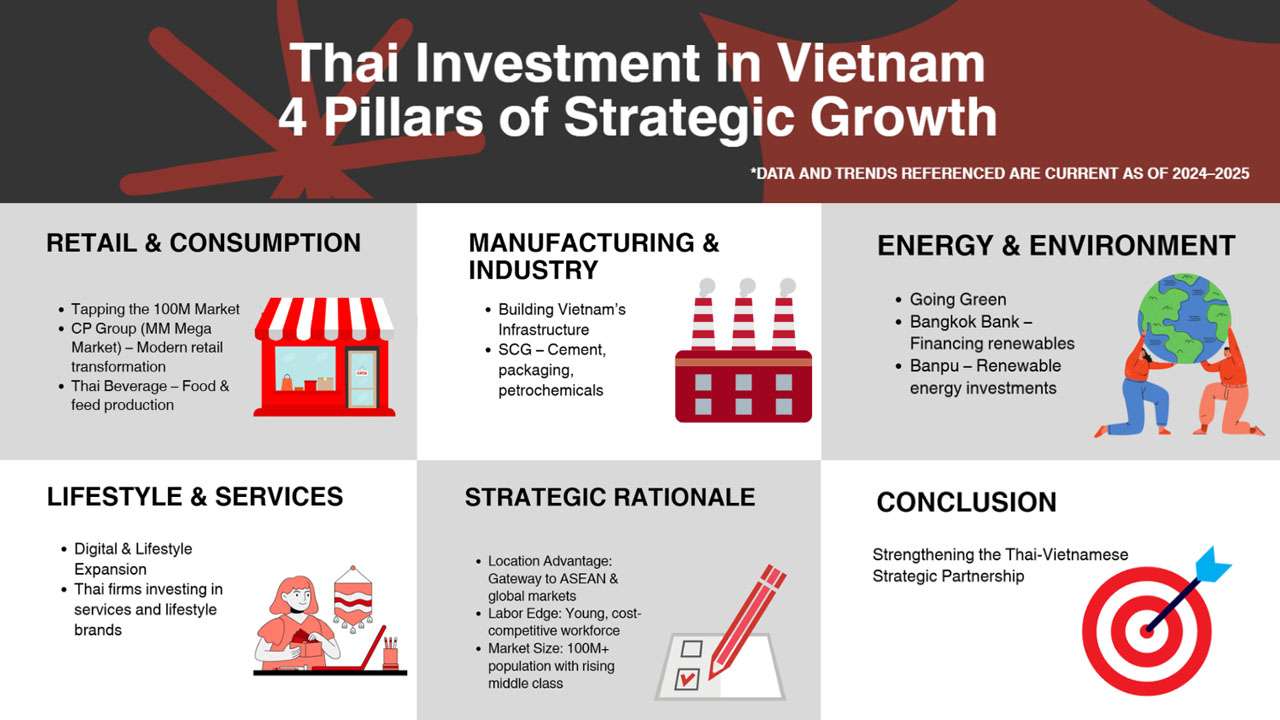
Thai Giants Spearheading the FDI Wave
Thai Foreign Direct Investment (FDI) consistently ranks high. Thailand is among the top 10 investors in Vietnam. These investments focus on high-growth sectors.
- Retail & Consumer Goods: Major Thai players lead this sector. Central Group, through MM Mega Market Vietnam, has redefined modern retail. This firm acquired Metro Cash & Carry Vietnam previously. This strategic move captured a significant market share. CP Group also commands a massive presence. They are a leader in agriculture and the food production chain (CP Vietnam).
- Petrochemicals & Construction Materials: SCG (Siam Cement Group) has made substantial, long-term investments. They lead in petrochemicals, cement, and packaging. SCG’s involvement is crucial to development. It supports Vietnam’s rapid infrastructure growth. Furthermore, they continuously expand their manufacturing facilities.
- Beverage and Food Industry: The TCC Group holds key stakes. They invest heavily in Vietnam’s beverage market. Their ownership in Sabeco, the largest brewer, shows strong confidence. This strategy focuses on tapping the thriving domestic consumer market.
- Finance and Energy: Thai banks, notably Bangkok Bank, provide financial support. They serve Thai investors and local businesses well. Additionally, Thai energy firms are investing more. They focus on renewable energy projects there. These investments capitalize on Vietnam’s need for sustainable power.
Cultural Influence: Series, Fashion, and Language
People-to-people relations are a vital dimension of the Thailand Vietnam Relations. This shows an intense, reciprocal cultural exchange.
- Thai Wave in Vietnam:
- Thai Series Popularity in Vietnam: Thai dramas enjoy massive popularity. They are very popular among Vietnamese youth. This includes Boys’ Love (BL) and romantic comedies. This Thai Soft Power in Vietnam helps Thai brands. Thai fashion and lifestyle easily access the Vietnamese market.
- Fashion: Thai fashion and brands are well-known. They are also highly favored by consumers.
- Tourism: Vietnamese tourist numbers to Thailand grow constantly. They reached over a million annually before the pandemic.
- Vietnamese Influence in Thailand:
- Vietnamese Food in Thailand: Vietnamese cuisine has been popular for ages. Signature dishes like Nem Nướng and Phở are beloved. Bánh Xèo (Vietnamese Sizzling Cake) is also a favorite. They have become staple foods for many Thais.
- Vietnamese Language: Thai youth show growing interest in learning the Vietnamese language. They see future job opportunities. Vietnam has rapid economic growth. It is an important trade gateway.
The Charm of Cuisine: A Shared ASEAN Heritage
Food vividly connects the life and culture of both nations. Both Thai and Vietnamese cuisines are world-famous. They share a characteristic: diverse Street Food culture.
- Vietnamese Food: Vietnamese cuisine is known for its freshness. It uses various vegetables and herbs. The flavors are subtle and balanced. Examples include Phở (noodle soup) and Banh Mi (Vietnamese sandwich). Nem Nướng remains a top choice in Thailand.
- Thai Food: Thai food is equally popular in Vietnam. Its distinct and vibrant flavors appeal widely. This demonstrates that food, even with different tastes, serves as a strong bridge. It is a bridge for friendship and shared enjoyment.
Conclusion and Outlook
This analysis, on day two in Vietnam, paints a clear picture. The Thailand Vietnam Relations rest on an intriguing balance. Both countries moved past cautious historical ties. They are now a Thai-Vietnamese Strategic Partnership. This involves cooperation for mutual economic gain and security. In addition, cultural development is shared across the region. Although they compete in certain industries, one’s growth often creates opportunities for the other.
My time here is more than just travel. I have witnessed the dynamic growth of this region firsthand.
My stay in Vietnam continues for another two to three days. I plan to gather further data on modern culture and investment trends. If I find new, interesting information, I will update this article again. The next update will be after my return to Thailand.
Follow us for more insider guides and updates on Thailand’s top destinations and experiences. @thaiimpact on x.com


